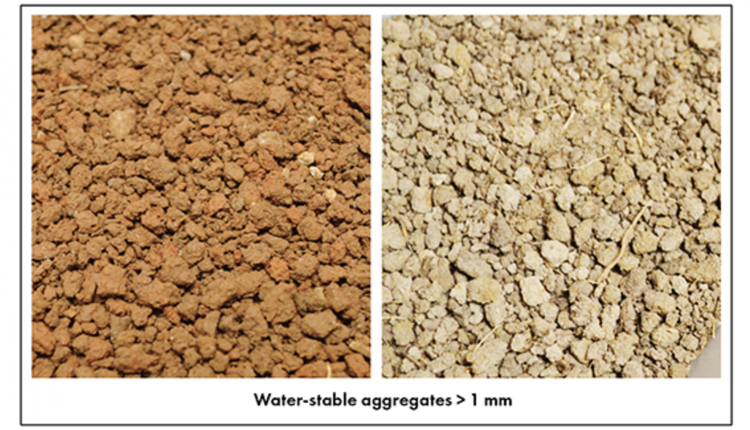Several forces bind soil |
| By Alan Franzluebbers |
|
|
|
The author is a soil scientist with the USDA Agricultural Research Service in Raleigh, N.C.  Soil aggregation is the clustering of the smallest soil particles — clay and silt-sized particles that would often be too small to see as individual particles — into larger soil crumbs that resemble small stones or pebbles. These clusters of soil particles are bound together by a variety of organic and inorganic gluing mechanisms. Historically, soil science has focused on inorganic glues that bind soil particles by electrostatic forces, chemical bridges, and chelating agents. However, soil biological mechanisms can be equally important in cementing soil particles together into stable crumbs that create a diversity of soil pore sizes between these crumbs but also keep their strong cationic attraction forces. Root of attraction Plant roots often find their way through soil by exploring the path of least resistance, following water and nutrients in the spaces between soil crumbs (or aggregates). These growing roots deposit water-soluble and other by-products of growth onto and between soil crumbs. Earthworms and other soil animals might also push soil particles to the side to consume soil and organic resources deposited in soil. All of this tugging and pushing, along with the deposition of fecal pellets and various reworked soil and carbon substrates, leads to a dynamically structured soil. Soil fungi and bacteria are consuming these root-derived inputs continuously, but they are also leaving behind some of the glues that bind soil particles together. Further, as soil dries and rewets over and over, it becomes more structured over time. The activity of soil microorganisms and roots are key elements of soil aggregation. Since these factors are most active near the soil surface, soil aggregation is also strongest near the soil surface. One way to measure the impact of soil management on aggregation is by determining the soil stability index. This index measures the average size of aggregates following a short period of immersion and oscillation in water relative to the average size of aggregates following light crushing of dried soil. A grassland advantage Vigorously growing forage plants produce an abundance of roots to extract water and nutrients. They are also secreting carbon substrates that feed soil microorganisms to glue soil particles into aggregates. In a recent survey of paired land uses across 25 sites in North Carolina, soil stability index was 94% under grassland fields. This meant that nearly all dry aggregates were stable in water and did not fall apart. The index was the same as soil under undisturbed woodlands. Croplands had lower stability index values, falling to 75% when managed with no-till and only 62% when managed with conventional disk tillage. Land management effects were stronger in fine-textured soils (more clay and silt), but the positive impact of conservation management with grass roots occurred even in coarse-textured soils (more sand). Therefore, forage-based agriculture can improve soil aggregation in a variety of soils.  For more detailed information on soil aggregation and its determination in agricultural systems, scan the QR code. This article appeared in the February 2023 issue of Hay & Forage Grower on page 16. Not a subscriber? Click to get the print magazine. |
